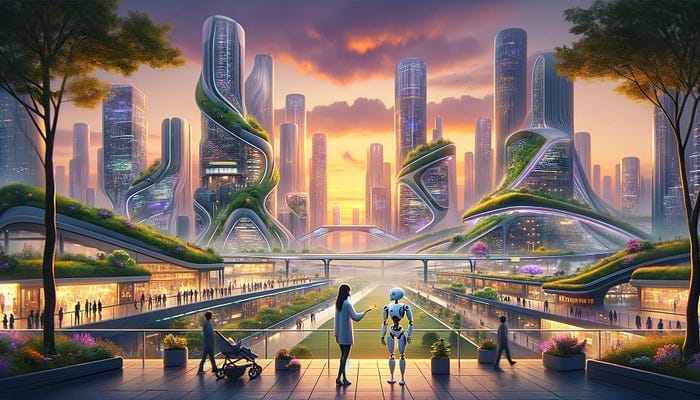Navigating the Complexities of Artificial Intelligence

In an age where the boundaries between science fiction and reality blur, the rapid advancement of artificial intelligence (AI) presents a paradigm shift in human technological progress and philosophical inquiry. As we stand on the precipice of a new era, the narrative of AI’s evolution from a mere concept to an integral part of our daily lives demands a closer examination. Through the lens of innovative projects and the exploration of AI’s potential to redefine human-machine interaction, this short essay delves into the complexities and promises of artificial intelligence, balancing the hopeful vision of technological utopia with the cautionary tales of dystopia.
Historically, technological advancements have transformed societies in waves, but more slowly and profoundly than artificial intelligence. From the millennia it took to progress from writing to the printing press to the relatively swift leap to digital communication, technology’s pace has accelerated exponentially. This acceleration underscores a pivotal moment in history: the dawn of the AI era. As AI becomes more embedded in our lives, understanding its implications, demystifying its components, and grappling with its potential become crucial. Concepts such as machine learning, algorithms, computer vision, and Big Data, once the purview of specialists, now demand a broader public comprehension to navigate the future intelligently and ethically.
Central to the discourse on AI is the endeavor to make artificial intelligence as lifelike and empathetic as possible. Projects like “Baby X” by Mark Sagar’s Soul Machines represent pioneering steps towards creating digital consciousness. By simulating a toddler who can see, listen, and respond to stimuli through AI, these innovations aim at technological showmanship, understanding, and replicating the nuances of human consciousness and emotions. This approach to AI challenges the conventional view of technology as a tool, proposing a future where humans and machines collaborate, learn from each other, and possibly even coexist.
Will.i.am’s exploration of AI by creating a digital avatar exemplifies another facet of AI’s potential: extending human creativity and presence. By blurring the lines between creator and creation, AI avatars promise a new realm of personal expression and interaction. They enable individuals to exist in multiple places simultaneously, thus redefining the concept of identity in the digital age.
Developing advanced prosthetics, such as the Skywalker Hand, illustrates AI’s potential to transcend traditional boundaries and directly enhance human capabilities. This innovation, which leverages ultrasound technology to allow amputees to move fingers individually, signifies a leap towards integrating AI in ways that restore, improve, and even augment human physical abilities. Such advancements showcase AI’s technical prowess and highlight its role in addressing profound human challenges and aspirations.
The journey into the AI era is fraught with ethical dilemmas and philosophical questions. The creation of lifelike avatars and digital consciousness raises issues of identity, autonomy, and the essence of what it means to be human. As AI begins to mimic human emotions and decision-making, the line between the creator and the creation blurs, prompting us to reconsider the nature of intelligence, consciousness, and free will. Furthermore, the potential for AI to impact every aspect of human life, from creativity to interpersonal relationships to solving global challenges, necessitates carefully considering how we design, implement, and govern AI technologies.
As we navigate the complexities of the AI era, artificial intelligence holds immense promise for profoundly transforming society. Yet, alongside this promise lies a web of ethical, philosophical, and practical challenges that must be addressed. Balancing the optimism for AI’s potential to augment human creativity, enhance capabilities, and solve complex problems with the cautionary tales of potential risks is essential. The future of AI, therefore, lies not only in the hands of technologists and innovators but also in a societal dialogue that embraces the nuances of human-machine coexistence. In this new era, pursuing AI is not just a technological endeavor but a profound journey into the heart of what it means to be human in a world where the lines between biological and artificial intelligence increasingly fade.
Join Us Towards a Greater Understanding of AI
I hope you found insights and value in this post. If so, I invite you to become a more integral part of our community. By following us and sharing our content, you help spread awareness and foster a more informed and thoughtful conversation about the future of AI. Your voice matters, and I’m eager to hear your thoughts, questions, and suggestions on topics you’re curious about or wish to delve deeper into. Together, we can demystify AI, making it accessible and engaging for everyone. Let’s continue this journey towards a better understanding of AI. Please share your thoughts with me via email: marty@bearnetai.com, and don’t forget to follow and share BearNetAI with others who might also benefit. Your support makes all the difference.
Thank you for being a part of this fascinating journey.
BearNetAI. From Bytes to Insights. AI Simplified.
Categories: Technology and Innovation, Philosophy of AI, Ethics of AI, AI in Society, Science Fiction and Reality, Future Studies, Human-Computer Interaction (HCI), Digital Ethics and Governance
The following sources are cited as references used in research for this BLOG post:
Artificial Intelligence: A Guide for Thinking Humans by Melanie Mitchell.
Life 3.0: Being Human in the Age of Artificial Intelligence by Max Tegmark.
Superintelligence: Paths, Dangers, Strategies by Nick Bostrom.
Human Compatible: Artificial Intelligence and the Problem of Control by Stuart Russell.
© 2024 BearNetAI LLC